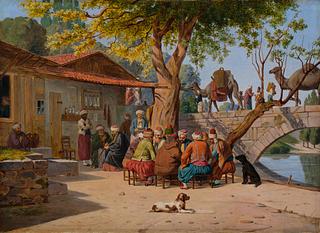Martinus Rørbye (1803–1848)
The Caravan Bridge at Smyrna, 1838
Oil on canvas
32.2 x 44.4 cm
Inventory number 18/2021
The year after his return from a long trip abroad in the years 1834–1837, which took him to many places, including Turkey (16/1990), Martinus Rørbye became a member of the Academy in Copenhagen. At the time, prospective members had to do a so-called admission piece representing a subject set by the Academy. In the case of painters, the nature of the subject was determined by the genre in which the relevant artist had specialised. Thus, Rørbye was tasked with producing a genre scene, specifically one set in Turkey because his work from the Orient had been met with unusually great interest.1
On his journey by steamship from the Greek city of Piraeus to Constantinople (present-day Istanbul) in mid-December 1835, Rørbye and his travel companion, the architect Gottlieb Bindesbøll (1800–1856), spent a few days in the Turkish city of Smyrna (present-day Izmir). They explored the city and its sights together, including the Caravan Bridge. Rørbye could not draw it at the time due to cold weather, so he returned the following day, as he reports in his diary:
‘In the morning I strolled once again to the Ponte del Caravani, intending to draw a little, but things are still almost too fantastical here; one has hardly recovered after seeing some peculiar figure or thing before another, even more wondrous one presents itself. Long lines of camels leading and carrying black people, gaudy costumes everywhere, and a very beautiful landscape.”2
The quote is among the best testimonies available to us about the fascinating, alien world that revealed itself to Rørbye in Smyrna, as no scenes from this place have been found among his many surviving drawings.3 Even so, he must have made records of some kind, because the following year he created his admission piece for the Academy, Scene from Public Life in the Orient, for which the picture in The David Collection is a study.4 Today, there is nothing to confirm whether Rørbye made use of observations that he recorded on his journey to Constantinople or around Greece. However, the caravan bridge seems to resemble the real caravan bridge quite well. More conspicuous are the other components of the picture, such as the dromedaries and the oriental costumes.
On his journey by steamship from the Greek city of Piraeus to Constantinople (present-day Istanbul) in mid-December 1835, Rørbye and his travel companion, the architect Gottlieb Bindesbøll (1800–1856), spent a few days in the Turkish city of Smyrna (present-day Izmir). They explored the city and its sights together, including the Caravan Bridge. Rørbye could not draw it at the time due to cold weather, so he returned the following day, as he reports in his diary:
‘In the morning I strolled once again to the Ponte del Caravani, intending to draw a little, but things are still almost too fantastical here; one has hardly recovered after seeing some peculiar figure or thing before another, even more wondrous one presents itself. Long lines of camels leading and carrying black people, gaudy costumes everywhere, and a very beautiful landscape.”2
The quote is among the best testimonies available to us about the fascinating, alien world that revealed itself to Rørbye in Smyrna, as no scenes from this place have been found among his many surviving drawings.3 Even so, he must have made records of some kind, because the following year he created his admission piece for the Academy, Scene from Public Life in the Orient, for which the picture in The David Collection is a study.4 Today, there is nothing to confirm whether Rørbye made use of observations that he recorded on his journey to Constantinople or around Greece. However, the caravan bridge seems to resemble the real caravan bridge quite well. More conspicuous are the other components of the picture, such as the dromedaries and the oriental costumes.
Published in
Published in
Fortegnelse over Generalkonsul Johan Hansens Samling af dansk Kunst, Kastelsvej 16, København 1917, no. 637 (”Scene ved Karavanebroen ved Smyrna”);
”Johan Hansens Malerisamling”, Illustreret Tidende, year. 58, no. 55, 21/10 1917, p. 334 (afbildet med billedtekst: ”Orientalere. Karavanebroen ved Smyrna”);
V. Jastrau: Martinus Rørbye, København 1933 (Smaa Kunstbøger; 22), p. 37 (with the text ”Scene af det orientalske liv. Karavanevej ved Smyrna”, but Kunstakademiet wrongly named as the owner);
Dyveke Helsted [et al.]: Martinus Rørbye 1803-1848, Thorvaldsens Museum, København 1981, M. 156, p. 216 (”Scene af det offentlige liv i Orienten. Forarbejde eller forenklet gentagelse af M. 155”) samt p. 143;
Bruun Rasmussen: Malerier og antikviteter, Fine art + antiques, auction 903, 21.-.23.september 2021, lot 16, pp. 34-35;
”Johan Hansens Malerisamling”, Illustreret Tidende, year. 58, no. 55, 21/10 1917, p. 334 (afbildet med billedtekst: ”Orientalere. Karavanebroen ved Smyrna”);
V. Jastrau: Martinus Rørbye, København 1933 (Smaa Kunstbøger; 22), p. 37 (with the text ”Scene af det orientalske liv. Karavanevej ved Smyrna”, but Kunstakademiet wrongly named as the owner);
Dyveke Helsted [et al.]: Martinus Rørbye 1803-1848, Thorvaldsens Museum, København 1981, M. 156, p. 216 (”Scene af det offentlige liv i Orienten. Forarbejde eller forenklet gentagelse af M. 155”) samt p. 143;
Bruun Rasmussen: Malerier og antikviteter, Fine art + antiques, auction 903, 21.-.23.september 2021, lot 16, pp. 34-35;
Footnotes
Footnotes
1.
Martinus Rørbye, Scene of Public Life in the Orient, 1838, The Royal Danish Academy of Fine Arts, Copenhagen.
2.
Birgitte von Folsach: ‘Martinus Rørbye blandt grækere og “Musselmænd”’ in Birgitte von Folsach and Sidsel Maria Søndergaard (eds.): Martinus Rørbye. Det nære og det fjerne, Øregaard Museum, Hellerup Museum, Hellerup 2014, p. 213.
3.
Martinus Rørbye’s travel diaries and letters, 16 December 1835, diary B, page 107 recto, The Royal Danish Library NKS 2923, 4. Cited by MA and PhD Jesper Svenningsen; Kilder til dansk kunsthistorie (https://roerbye.ktdk.dk/n/EsjYVRit). Citation translated by René Lauritsen.
4.
A few weeks after Rørbye’s return to Denmark, an exhibition of his work was shown at Kunstforeningen in Copenhagen. Due to the great interest, the show included not only finished paintings but also oil studies and drawings. See Kasper Monrad: Dansk guldalder. Lyset, landskabet og hverdagslivet, Copenhagen 2013, p. 260.
Danish Paintings and Drawings
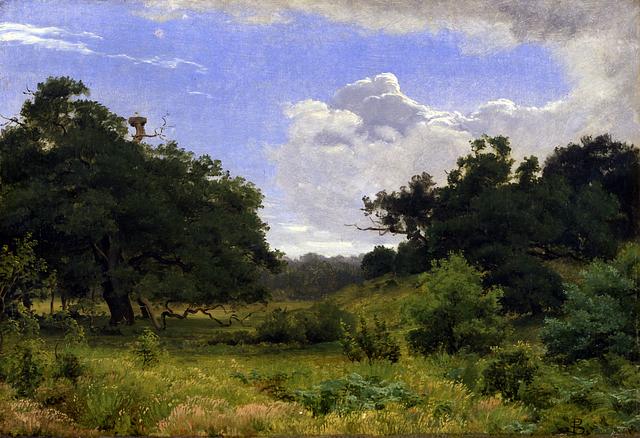
P.C. Skovgaard (1817–1875)
The North Woods at Jægerspris, 1842–1843
Oil on canvas
The North Woods at Jægerspris, 1842–1843
Oil on canvas
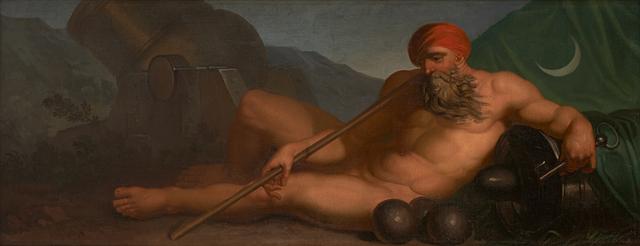
Nicolai Abildgaard (1743–1809)
Bosporus, c. 1800
Oil on canvas
Bosporus, c. 1800
Oil on canvas
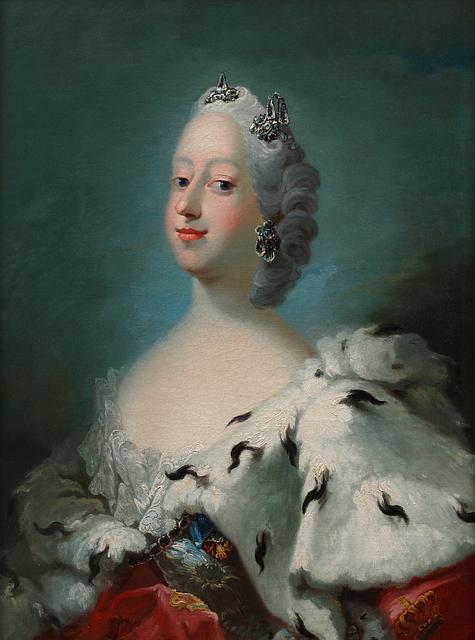
Peder Als (1726–1776)
Queen Louise, Consort of Frederik V, 1750s
Oil on canvas
Queen Louise, Consort of Frederik V, 1750s
Oil on canvas
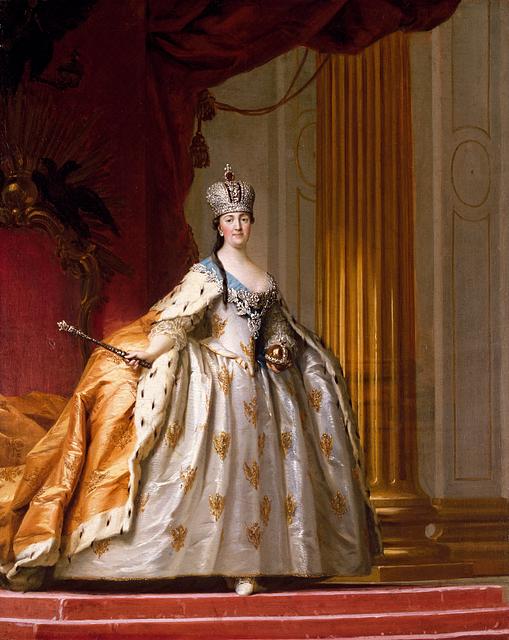
Vigilius Eriksen (1722–1782)
Catherine the Great in Her Coronation Robe, 1778–79
Oil on canvas
Catherine the Great in Her Coronation Robe, 1778–79
Oil on canvas
